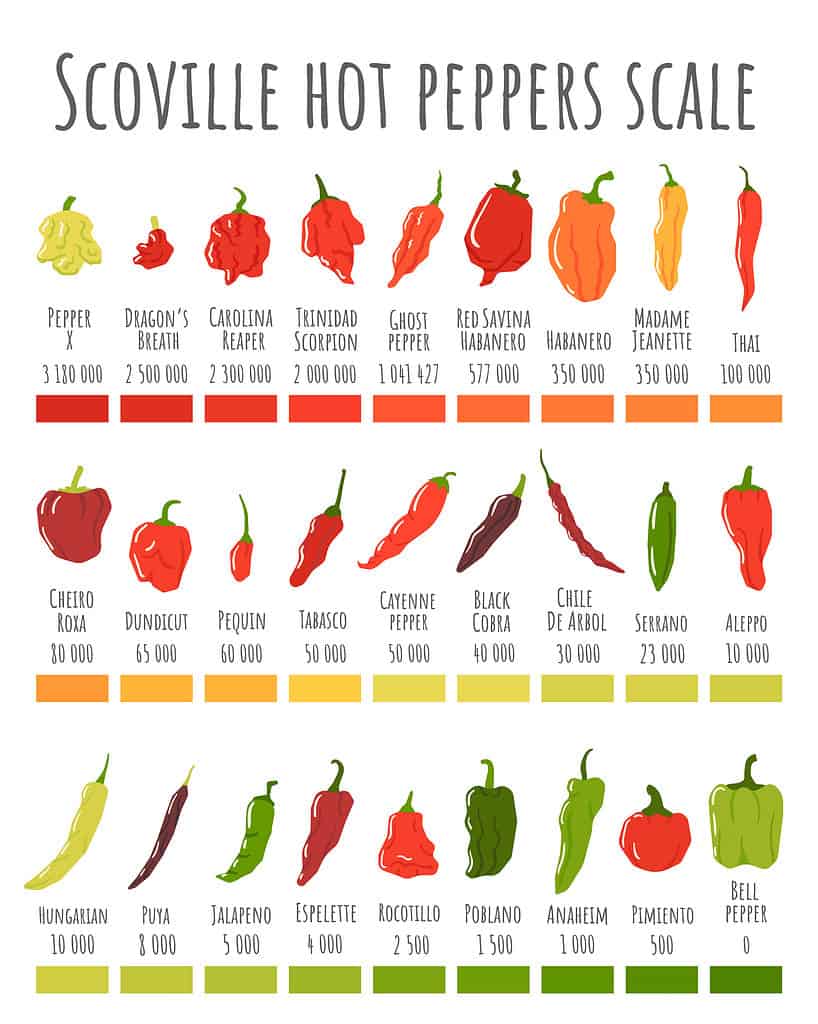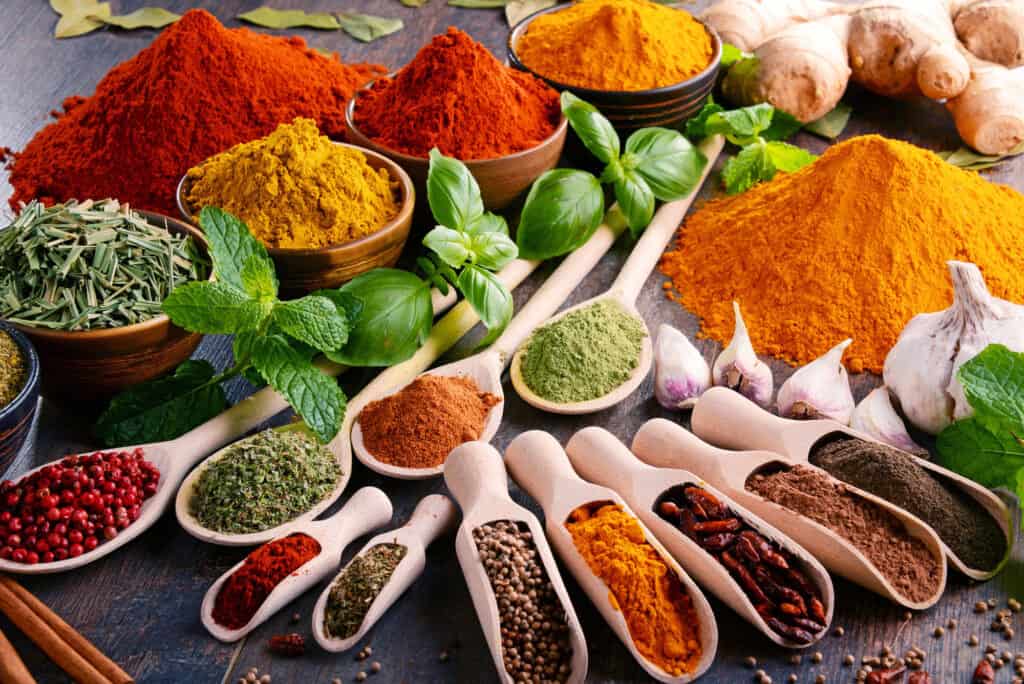Black pepper is a spice used widely in culinary dishes worldwide. It’s been valued for centuries for its flavor and medicinal properties. Harvested from the pepper plant, it’s a flowering vine native to South India but is now cultivated in many other tropical regions. It’s one of the most traded spices globally and a staple in most households’ spice racks. But just how hot is black pepper on the Scoville scale?
We find out in this article. Plus, we’ll explore black pepper’s history, cultivation, culinary uses, health benefits, and heat levels, providing you with a comprehensive understanding of this versatile spice.
How Hot is Black Pepper?
Black pepper heat is measured on the Scoville scale, a measurement of the amount of capsaicin, the compound responsible for the heat in chili peppers.
But black pepper doesn’t contain capsaicin. Instead, it contains piperine, which has a similar effect on the taste buds.
Black pepper typically measures between 30,000 and 100,000 SHU on the Scoville scale. This may seem like a wide range, but note that the heat level can vary depending on the type of black pepper and how it is used in a dish.
For example, whole peppercorns will have a milder flavor than ground pepper, as the outer layer of the peppercorn contains less piperine.
Factors Affecting Heat
Black pepper’s heat level can is affected by the following:
- Where it’s grown
- How it’s processed
Peppercorns grown in hotter climates tend to be hotter, while those grown in milder climates may have a milder flavor.
Additionally, how the peppercorns are processed can affect the level of heat. Peppercorns left to ripen longer on the vine will have a milder flavor, while those picked earlier and dried more quickly will be spicier.
What Are Scoville Heat Units?

The Scoville can help us answer the question of how hot is black pepper.
©iStock.com/Veronika Oliinyk
Scoville heat units (SHU) measure the spiciness or heat of a chili pepper or a spice derived from chili peppers. SHU measures the concentration of capsaicinoids, which are the compounds responsible for the heat in chili peppers and spices.
SHU is named after its inventor, Wilbur Scoville, the brains behind the Scoville Organoleptic Test developed in 1912.
This test involves diluting an alcohol-based chili pepper or spice extract with sugar water until a tasters’ panel can no longer detect the heat. The ratio of the dilution is the SHU value.
The Scoville Organoleptic Test was the standard method for measuring SHU until the 1980s, when new analytical methods emerged. These newer methods are more accurate and precise than the Scoville Organoleptic Test and can detect a wider range of capsaicinoids.
Importance of SHU in Determining Spice Heat
SHU is important for three main reasons:
- It allows consumers to gauge the spiciness of a particular spice or pepper and choose one that matches their tolerance level.
- It’s essential for the food industry to maintain consistent levels of heat in their products.
- It’s valuable for research purposes to study the properties and effects of capsaicinoids.
Overall, SHU is vital for anyone involved in producing, marketing, or consuming spicy foods.
Scoville Heat Units Measurement Methods
Several methods are available for measuring SHU, each with advantages and disadvantages. The choice of method depends on the intended use and available resources. The most common methods include:
- Scoville Organoleptic Test
- High-Performance Liquid Chromatography—HPLC
- Gas Chromatography
- Liquid Chromatography-Mass Spectrometry—LC-MS
Scoville Organoleptic Test
The Scoville Organoleptic Test remains the most widely recognized method for measuring SHU. This method involves diluting an alcohol-based chili pepper or spice extract with sugar water until a tasters’ panel can no longer detect the heat.
The Scoville rating is determined by the number of dilutions required to achieve this result. Although this method is subjective and dependent on the panel of tasters, it remains a useful tool for measuring SHU.
HPLC
HPLC is a widely used method for measuring SHU. It involves separating capsaicinoids from other compounds in the sample and measuring their concentration using a detector.
HPLC is highly accurate and precise, and it can detect a wide range of capsaicinoids.
Gas Chromatography
GC is another method used for measuring SHU. It involves separating and quantifying the capsaicinoids in a sample using a gas chromatograph.
GC is highly sensitive and can detect very low levels of capsaicinoids. But it requires specialized equipment and trained personnel.
LC-MS
This is a more advanced method for measuring SHU that combines the following methods:
- Liquid chromatography, known for its separation capabilities
- Mass spectrometry, known for its detection capabilities
This method is highly accurate and can identify specific capsaicinoids. But it’s also more complex and expensive than other methods.
History of Black Pepper

Image: Spalnic, Shutterstock
©Spalnic/Shutterstock.com
Black pepper has a long and fascinating history dating back thousands of years.
Origin of Black Pepper
Black pepper’s origin can be traced back to South India, where it was grown and traded as early as 2,000 BC.
The spice was so valuable here that it was often called “black gold.” It was used in trade between India and the Middle East.
Importance of Black Pepper in Ancient Times
Black pepper’s popularity continued to grow, and it soon became one of the most important commodities in the ancient world.
It was used for medicinal purposes and was believed to cure a range of illnesses, including:
- Constipation
- Diarrhea
- Gangrene
The Greeks and Romans also used black pepper extensively in their cooking. As a result, it was a common ingredient in many of their recipes.
Trade and Commerce of Black Pepper
During the Middle Ages, black pepper was one of the most valuable commodities in the world. It was so highly prized that it was often used as a form of currency. It was even traded for gold. The spice trade was established, and Arab traders controlled most spice routes that linked the East and the West. During this time, black pepper became a symbol of wealth and status.
In the 15th century, the Portuguese established trade routes to the East. These routes allowed them to bring spices such as black pepper to Europe. This led to the spice trade and the creation of powerful spice trading companies.
One such company was the Dutch East India Company, which played a significant role in the colonization of Asia.
Today, black pepper is still an important commodity in international trade, with countries like Vietnam, India, and Brazil being major producers.
Cultivation of Black Pepper

Black pepper is harvested from green unripe berries on the vine.
©Melada photo/Shutterstock.com
Black pepper is grown in many countries worldwide. India, Vietnam, Indonesia, and Brazil are the largest producers.
Growing Process
The pepper plant is a tropical vine that requires a warm and humid climate to grow.
The plant is grown from cuttings planted in nutrient-rich soil and trained to climb a support structure.
The pepper plant takes around 3-4 years to mature. Once it reaches maturity, it can continue to produce pepper for up to 20 years.
Harvesting
The plant produces small, white flowers that develop into clusters of green berries.
As the berries mature, they turn yellow, followed by orange, and finally, red. Black pepper is made from the unripe green berries harvested just before they turn yellow.
The Drying Process
The harvested berries are then dried in the sun or a mechanical dryer until they turn black and wrinkled.
This drying process gives black pepper its characteristic flavor and aroma and helps to preserve the berries for long-term storage.
The dried berries then undergo sorting, grading, and packaging for shipment to markets worldwide.
Black pepper can be purchased in several forms, including:
- Whole peppercorns
- Ground pepper
- Pepper oil
Whole peppercorns are often used in cooking and can be ground fresh with a pepper mill. In addition, ground pepper is convenient for spice blends and marinades, while pepper oil is often used in aromatherapy and massage.
Culinary Uses of Black Pepper

Black pepper is often in many spice cabinets and is also part of spice blends.
©iStock.com/monticelllo
Black pepper is a versatile spice used in cuisines worldwide. It has a pungent, slightly bitter flavor and is often used to add heat and depth to dishes. Some culinary uses of black pepper include:
- Seasoning
- Spice blends
- Baked goods
- Table pepper
Seasoning
Black pepper is a popular seasoning for dishes such as:
- Meat
- Poultry
- Fish
It’s often used in:
- Marinades
- Rubs
- Spice blends
It helps to add flavor and tenderize meats. Black pepper can also be added to sauces and gravies to give them a spicy kick.
Spice Blends
Black pepper is a key ingredient in many spice blends, such as:
- Curry powder
- Garam masala
- Chinese five-spice
These blends are used in various dishes. Adding black pepper can add depth and complexity to a recipe.
Baked Goods
Black pepper is used in savory dishes and sweet baked goods. It’s often used in:
- Gingerbread
- Spice cakes
- Cookies
It adds a warm, spicy flavor.
Table Pepper
Perhaps the most common use of black pepper is as a table spice.
Ground black pepper can be found on nearly every dining table and is often used to season the following:
- Soups
- Salads
- Vegetables
Health Benefits of Black Pepper

Black pepper offers several health benefits, including brain health.
©Life science/Shutterstock.com
Black pepper not only adds flavor to food but also provides several health benefits, including:
- Anti-inflammatory properties
- Digestive Health
- Antioxidant properties
- Respiratory health
- Brain Health
Let’s find out more about each benefit.
Anti-inflammatory Properties
Black pepper contains piperine, a natural compound with anti-inflammatory properties.
Studies have shown that piperine can help to reduce inflammation in the body, which may help to alleviate symptoms of conditions such as arthritis.
Digestive Health
Black pepper has been used for centuries to aid digestion. It stimulates the production of digestive enzymes and can help improve nutrient absorption.
Black pepper is been shown to help relieve bloating and constipation.
Antioxidant Properties
Black pepper is a good source of antioxidants. These compounds protect the body from damage by harmful free radicals.
They can prevent chronic diseases like heart disease and cancer.
Respiratory Health
Black pepper has been used for centuries to treat respiratory problems such as coughs and colds.
It has a warming effect on the body and can help to break up mucus and phlegm, making breathing easier.
Brain Health
Black pepper contains piperine, known to have cognitive-enhancing effects. According to research, piperine can improve memory and attention and may even help to prevent age-related cognitive decline.
Key Takeaways
Black pepper is a versatile spice that has been used for thousands of years for culinary and medicinal purposes. From its humble origins in India to its widespread use in kitchens worldwide, black pepper has a rich history and a unique flavor profile.
Not only does black pepper add depth and complexity to dishes, but it also provides several health benefits. From reducing inflammation to improving digestive health and cognitive function, black pepper is valuable to any diet.
Whether you prefer it freshly ground or whole, black pepper is a staple spice that can enhance any meal’s flavor and nutritional value. So next time you’re in the kitchen, don’t forget to add a dash of black pepper to your dishes!
The photo featured at the top of this post is © Melada photo/Shutterstock.com
Thank you for reading! Have some feedback for us? Contact the AZ Animals editorial team.






